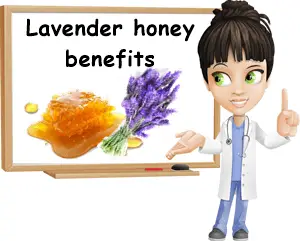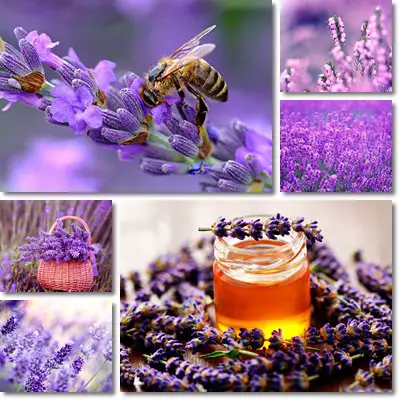Lavender (Lavanduala) is an aromatic plant in the mint family that comprises several dozens of different varieties used primarily for the production of the fragrant lavender oil, but also for ornamental purposes. However, lavender flowers are also a source of food for honey bees, their nectar being used to make lavender honey. Lavender honey is a delicate, aromatic monofloral variety of honey with multiple beneficial health effects, notably antibacterial and antiseptic action, antioxidant and digestive benefits and soothing and calming properties.
What is lavender honey made of? The variety is made primarily from nectar honey bees collect from lavender flowers. However, honey bees also collect pollen which is incidentally added to the honey. And despite the fact that pollen is one of the main allergens in honey, it is also a beneficial compound that adds to its antibacterial properties and basically makes honey what it is. Moreover, it is based on the pollen content that we can determine whether or not a honey is monofloral or polyfloral and what flower nectar it is actually made of.

Pollen is what determines what variety a honey is. For example, lavender honey should contain mostly pollen from lavender flowers (around 45% of the total pollen count in the tested honey). Pollen from other plant species can be present in varying amounts in lavender honey or other monofloral varieties, but standard regulations say it’s the predominant type of pollen that determines the variety of honey. The most common lavender species used to make honey are: Lavandula angustifolia (true lavender or common lavender), Lavandula stoechas (Spanish lavender), Lavandula latifolia and Lavandula intermedia (a hybrid variety).
What does lavender honey look like? The variety generally has a clear, very light yellow color with rich golden undertones and a viscous texture. Its appearance is reminiscent of sun rays trapped in a jar. The honey crystallizes in a matter of months. The process not only makes it solid, but also changes its color, making it turn a paler yellow-beige color. However, when a honey crystallizes, it is a good sign because it shows it hasn’t been messed with. Processing can prevent honey from crystallizing, but also takes away a lot of its beneficial properties, if not most of them.
What does lavender honey taste and smell like? Lavender honey has a delicately sweet and fragrant flavor and a warm taste with woody, floral notes and sometimes a citrus-earthy faint aftertaste. Its odor is only faintly reminiscent of lavender so if your store-bought honey has a strong lavender smell to it, it might just be infused with lavender, not real lavender honey. Because of its medium sweetness and light, floral flavor, the variety is a wonderful taste experience.
Differences in the appearance, taste and even fragrance of lavender honey may appear depending on the plant variety the bees had access to. For example, the Spanish Grosso variety of lavender (Lavandula stoechas) yields a honey with a less delicate flavor profile. This is suggested to be a result of the species higher content of an aromatic compound called camphor which instills the honey with a sour-bitter, almondy and not so pleasant aftertaste. Different lavender varieties or hybrids may result in a particularly light honey or a medium-amber honey.

What are the benefits?
What is lavender honey good for? Lavender honey is a unique variety that derives its health effects from beneficial compounds such as antioxidants, vitamins, minerals, enzymes, amino acids and others. Considering its composition, its most noteworthy properties and health benefits include:
1) Antibacterial and antiseptic action. Studies show lavender honey boasts mild antibacterial and antiseptic effects, meaning it helps not only inhibit bacterial growth, but also destroy pathogenic bacteria, hence its effectiveness in reducing wound healing time. However, because it has been found to have a less potent antibacterial effect than manuka and other honey varieties, it’s needed in higher concentrations to obtain the same effects. What gives lavender honey its antibacterial properties is it’s content of hydrogen peroxide, acidic pH and low moisture content. Hydrogen peroxide is a disinfectant and antimicrobial that occurs naturally in honey as a result of the interaction between glucose and an enzyme secreted by honey bees called glucose oxidase.
2) Useful for respiratory infections. Honey in general is a great natural remedy for cough and sore throat. Its viscous texture makes it great for a throat soreness, soothing irritation and allowing the throat lining to heal. Its antibacterial action helps reduce bacterial load, contributing to improving the evolution of respiratory tract infections such as the common cold and the flu and their symptoms. It is recommended to either add honey to tea or take it as it is. Raw, unprocessed, unfiltered honey is best because it still contains all of its beneficial components (pollen, nutrients etc).
It is also recommended to avoid heating honey because heat destroys most or all of its biologically active components. So when adding it to tea, it is important to allow the tea to cool down so its heat doesn’t alter the properties of the honey.
3) Soothing properties. Lavender honey is particularly soothing on mucous membranes, forming a sort of protective layer that prevents further irritation and allows the sensitive mucous linings to heal. It has been traditionally used for conditions such as gastritis, sore throat, sensitive skin, wounds, scars and burns. Preliminary studies recognize the effectiveness of honey for healing burns (Natural Standard Herb and Supplement Guide: An Evidence-Based Reference).
4) Helps relieve tension and pain. It would appear that lavender honey can help induce calmness, relaxation and reduce nervous tension because of its mild antispasmodic effects. These effects can be likened to those of lavender oil and lavender tea, but may be less pronounced. It has been theorized that certain biologically active compounds in various parts of the lavender plant are transferred to the honey through nectar and thus give it effects similar to those of other lavender preparations.
5) Antifungal action. Lavender honey appears to be particularly efficient against Candida albicans, Candida krusei and Cryptococcus neoformans, inhibiting the growth and spread of the fungi naturally (Antifungal effect of lavender honey against Candida albicans, Candida krusei and Cryptococcus neoformans). The honey was effective at higher concentrations (16%-30%) and the compound responsible for its antifungal properties has not been identified yet.
6) Beneficial for skin health. Like all honeys, lavender too is good for the skin. It can help reduce the frequency of acne breakouts naturally, both because it exerts a local antibacterial action and because it has a soothing effect, calming irritation and redness. Moreover, light honeys like lavender are great for dull skin, giving a natural glow and radiance to skin. They also help cleanse pores, further contributing to managing acne.
7) Nutritious and energizing. Lavender honey is a particularly good source of antioxidants, aromatic compounds and nutrients. It has been found to contain antioxidants such as phenolic acids, flavonoids, carotenoids and enzymes with antioxidant activity (glucose oxidase, catalase etc.) as well as nutrients such as vitamin C and dietary minerals (Antibacterial and Antioxidant Potency of Floral Honeys from Different Botanical and Geographical Origins). Moreover, lavender honey contains important amino acids and is a source of natural sugars. All of these elements contribute to its beneficial action.
I have found honey in general is a good solution for preventing hypoglycemia. Whenever I fell extremely low on energy I take on tablespoon of honey (acacia, pine nut, orange blossom, sunflower, lavander, whatever variety I may feel like at the time) and fill up on energy for another 20 minutes, giving me enough time to eat something good.
8) Source of amino acids. Research shows lavender honey has a particular amino acid profile, providing trace amounts of arginine, histidine, lysine, phenylalanine, proline, tyrosine and valine (Free amino acid composition and botanical origin of honey). It actually contains the highest content of the amino acid tyrosine, more than eucalyptus, rosemary, thyme and orange blossom honey. Tyrosine is needed for the synthesis of thyroid hormones and neurotransmitters such as dopamine, noradrenaline and adrenaline and is vital for the synthesis of the skin pigment melanin and Coenzyme Q10. While lavender honey is not enough to meet the body’s demands of the amino acid (poultry, beef, eggs, cheese, nuts are the best sources), it does provide it in small amounts, which adds to its beneficial action.
Lavender honey allergy
Like all honeys, lavender too can cause allergic reactions in predisposed individuals. Anyone allergic to lavender flower pollen, honey bee enzymes and other bee products should avoid consumption. If you are unsure, but are already allergic to the pollen of more than one flowering plant species or to other honeys, it is best to have a skin allergy test to know whether or not it is safe for you to eat lavender honey.
Conclusion
Overall, lavender honey is a wonderful variety of honey with a rich color, moderately sweet taste and delicate fragrance. It’s nutritious and energizing, great for skin care, respiratory infections and soothing on the stomach and throat. It has an impressive antibacterial and antifungal action and contributes to reducing healing time for wounds and burns. However, such properties and benefits are only present in the raw honey, unaltered by processing and heating that may deprive it of all its beneficial compounds.
